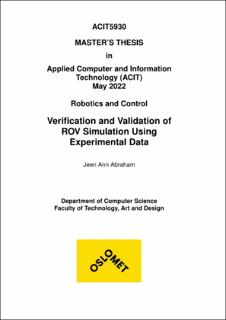| dc.description.abstract | Remotely operated vehicles (ROVs) are used widely in industries such as oil and gas, offshore, and renewable industries for various applications such as inspection, maintenance, and repair of their infrastructure. There is a great and underutilized opportunity for their scientific use across the world’s oceans with depths varying from a few hundred meters to depths greater than 4,000 m. The ROV operations are normally controlled by a human operator, and their hydrodynamic performance is far from the ideal behavior. As a result, the outcome of the task primarily depends on the operator’s experience. Model simulations that have close to real behavior can help in the training, development, testing, and verification of ROVs under varying test conditions and investigate critical situations cost-effectively without risking the safety of the user as well as equipment safety. This research was focused on developing a high precision ROV simulation platform under Robot Operating System(ROS) and MATLAB/ Simulink environment whose behavior stays as close to that of the hardware (IKM Subsea’s Merlin) experimental data. The performance of the ROV simulator was tested and validated against the real-time data captured from the Merlin. In the early phase, the focus was more on understanding the problem. To get an insight into the components and working principle of an ROV, several related research works were reviewed, followed by analyzing the relevant works done under this research topic, and the simulation software environment was set up. Later, a great deal of attention was directed toward the ROV kinematics and behavior of the dynamic model from the existing simulator. Data collection was done for both simulators and hardware. Semi-automated scripts were made for data collection and graphical representation to perform a comparative study. Also, work has been done for ROV hydrodynamic modeling and simulation in MATLAB to test the simulator behavior across independent simulation environments. Simulation and real-time experiments along with the results were presented to demonstrate the reliability of the ROV simulator over the hardware and thereby signify the possibility of replacing physical hardware with virtual hardware for various applications. | en_US |
